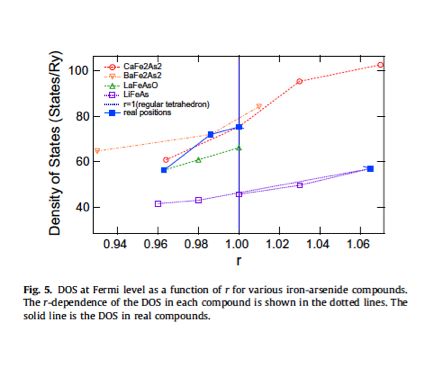The discovery of iron-based superconductors has attracted extensive researches because of its relatively
high critical temperature.
We have performed an ab initio band structure calculations for iron-pnictide compounds LaFeAsO, BaFe2As2, CaFe2As2 and LiFeAs [1].
We have used full-potential augmented plane-wave (FLAPW) scheme and exchange-correlation potential was constructed
within local-density approximation (LDA).
We found that LaFeOX and CaFe2As2 have many similarities in their band structures.
We also found that the degree of distortion of FeAs4
tetrahedra in LaFeAsO considerably changes the slope of the density of states
near the Fermi level, and this may account why ReFeAsO (Re=Nd, Sm,...)
have higher Tc than LaFeAsO when electrons are doped.
For all the above compounds, the density of states at the Fermi level
decreases when X atoms approach the Fe-Fe plane. This means that the
Fe d-band spreads greatly due to the hybridization between Fe and X orbitals.
In order to investigate the effect of the distortion of the FeAs4 tetrahedra, we have also calculated
the electronic structure with undistorted FeAs4 tetrahedra. We define the measure of the distortion of the
FeAs4 tetrahedron as
r = d(As1-As2)/d(As1-As1),
where d denotes the distance between two As atoms.
As1 and As2 indicate As atoms above and below the Fe plane, respectively.
For LaFeAsO, r = 0.964, and thus the tetrahedra are compressed in the
c-direction. On the other hand, CaFe2As2 has r &sim 1.
This indicates that FeAs4 tetrahedra are nearly undistorted.
For comparison, we also performed calculations for CaFe2As2 with r = 0.964
and r = 1.07. The former corresponds to LaFeAsO and the latter corresponds
to LiFeAs. In all the cases, we fixed all the other atomic parameters and
the lattice constants.
Our finding is that a higher Tc is possible if we can synthesize a
'distorted AFe2As2 (A = Ca, Ba)' by tuning the crystal structure chemically
or physically. We have obtained the density of state as follows:
D(EF) = 61, 75 and 103 [states/Ry] in the unit cell for r = 0.964, 1.00 and 1.07, respectively.
In other words, they are 2.2, 2.7 and 3.8 [eV-1] per Fe atom.
These values are large since they satisfy the Stoner condition
ID(EF)=1 if we use the exchange integral I = 0.7-0.9 eV.
For these large values, we can expect higher Tc if the magnetic instability
is suppressed.

This figure shows the density of states as a function of r [1]. When r >1, the tetrahedron is stretched upward.
The smaller r indicates that the tetrahedron is compressed. The figure means that the density of states is
increased when the tetrahedon is stretched for each iron compound. This indicates a possiblity of higher TC.
References
[1] I. Hase and T. Yanagisawa: Physica C470 (2010) 538.
| |

